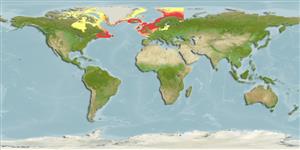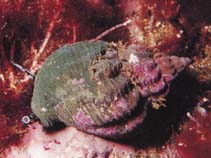Buccinum undatum Linnaeus, 1758
Waved whelk| Native range | All suitable habitat | Point map | Year 2050 |

|
| This map was computer-generated and has not yet been reviewed. |
| Buccinum undatum AquaMaps Data sources: GBIF OBIS |
Classification / Names Common names | Synonyms | CoL | ITIS | WoRMS
Gastropoda | Neogastropoda | Buccinidae
Environment: milieu / climate zone / depth range / distribution range Ecology
Benthic; depth range 0 - 600 m (Ref. 78657). Temperate, preferred 11°C (Ref. 107945); 85°N - 36°N, 110°W - 45°E
Distribution Countries | FAO areas | Ecosystems | Occurrences | Introductions
Arctic, Northern Atlantic and the Mediterranean: Canadian Arctic Archipelago and the Atlantic Ocean. Temperate to polar climates.
Length at first maturity / Size / Weight / Age
Maturity: Lm ?, range 5 - 7.2 cm Max length : 10.2 cm SHL male/unsexed; (Ref. 360); common length : 5.1 cm SHL male/unsexed; (Ref. 360)
Short description Morphology
Shell: not very thick, solid, conical spire, generally high, sometimes rather flattened spires, very convex whorls and markedly impressed suture; ovoidal aperture, outer lip is not thickened or toothed, lacks inner folds; columellar lip has a fairly striking callus, partly adheres to the ventral surface of the body whorl; sculpture has almost equidistant spiral grooves and quite big axial ribs that tend to fade at the edge of the body whorl and are generally sinous; yellowish white or light hazel in color; periostracum is light chestnut in color and not very resistant; operculum is horny, smaller than the aperture, has a central nucleus. Body: large foot, whole body cream with blackish patches; head has a pair of tentacles with an eye at the base of each, long proboscis; well-developed siphon; radula is rachnioglossan.
Maximum depth from Ref. 106864.
Life cycle and mating behavior Maturity | Reproduction | Spawning | Eggs | Fecundity | Larvae
Females gather in groups to deposit eggs in a communal mass of egg capsules where veligers develop and metamorphose inside and later hatch out as young individuals (Ref. 360).
Main reference
References | Coordinator | Collaborators
Harms, J. 1993. (Ref. 2711)
IUCN Red List Status (Ref. 130435: Version 2024-1)
CITES status (Ref. 108899)
Not Evaluated
CMS (Ref. 116361)
Not Evaluated
Threat to humans
Human uses
Fisheries: commercial
FAO - Fisheries: landings, species profile | FishSource | Sea Around Us
Tools
More information
Trophic Ecology
Ecology
Population dynamics
Life cycle
Distribution
Human Related
Aquaculture profile
Stamps, Coins Misc.
Stamps, Coins Misc.
Outreach
References
Internet sources
BHL | BOLD Systems | CISTI | DiscoverLife | FAO(Fisheries: species profile; publication : search) | Fishipedia | GenBank (genome, nucleotide) | GloBI | Gomexsi | Google Books | Google Scholar | Google | PubMed | Tree of Life | Wikipedia (Go, Search) | Zoological Record
Estimates based on models
Preferred temperature
(Ref. 115969): 7 - 11.8, mean 9.8 (based on 337 cells).
Resilience
(Ref. 69278):
Medium, minimum population doubling time 1.4 - 4.4 years (K=0.2-0.22; tm=7.5).
Prior r = 0.57, 95% CL = 0.37 - 0.85, Based on 1 data-limited stock assessment.
Nutrients : Calcium = 126 [75, 177] mg/100g; Iron = 4.79 [1.67, 7.92] mg/100g; Protein = 15.9 [14.8, 16.9] %; Omega3 = 0.331 [0.263, 0.400] g/100g; Selenium = 57.8 [48.5, 67.2] μg/100g; VitaminA = 0 μg/100g; Zinc = 1.97 [0.92, 3.02] mg/100g (wet weight); based on nutrient studies.



